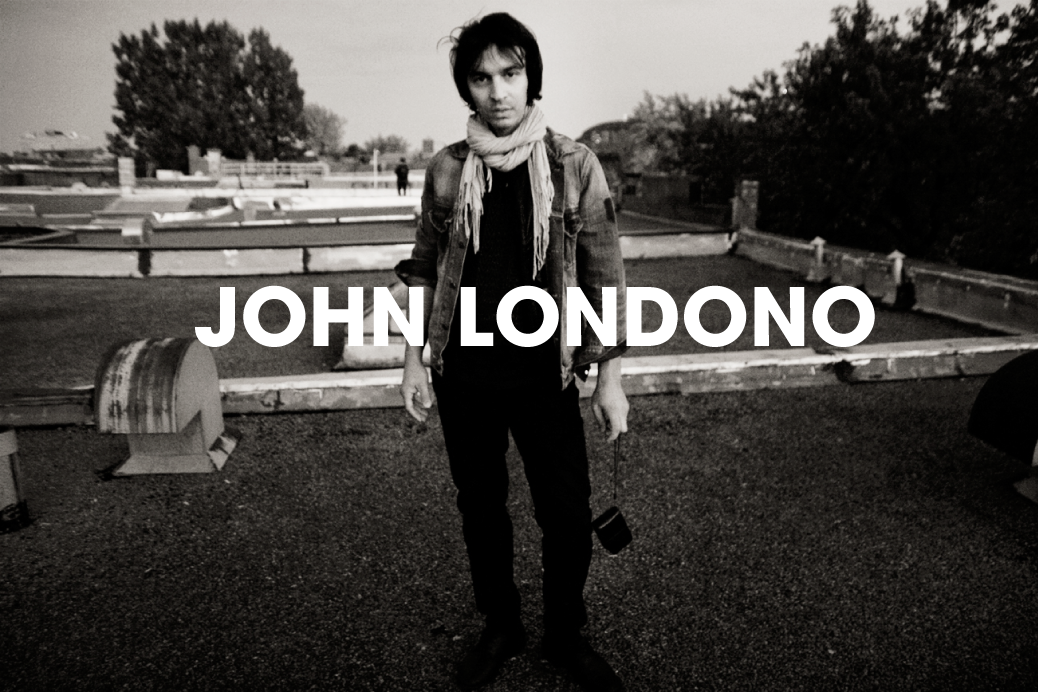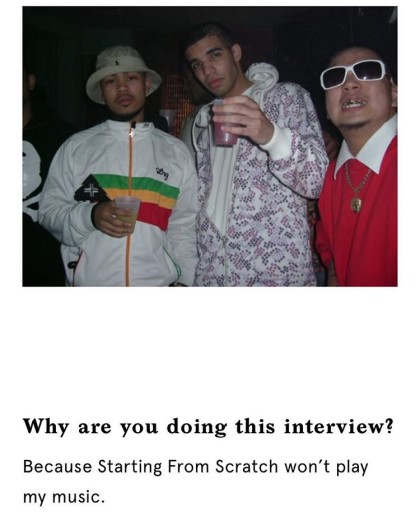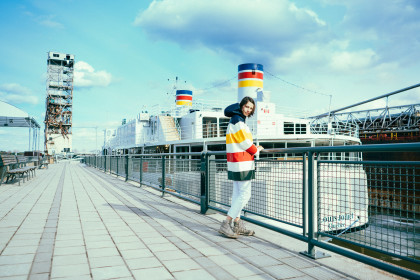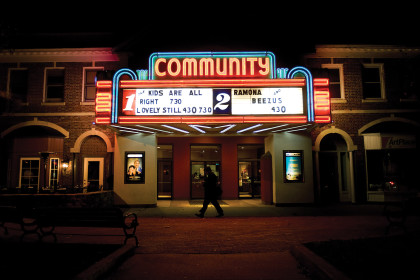
John Londono

Rodeo Productions says the following about de Gaspé near the tracks (in Montreal): it’s the most appropriate setting to meet a real Mile-Ender. He’s a stark observer of the city’s style and fame – John Londono knows bands, designers and actors and captures their creativity through his. Here’s a taste of what fashion feels like from behind the camera.
“I used to spend a lot of time in the dark room. I was really inspired by the history of photography, documentary in particular. What I was doing was with the same style, but talking about something different.”
John Londono did start out on the same path as some documentary photographers. John’s Quebecois dad was gone. His Columbian dad had passed too. So he set out to find his roots in Venezuela and Columbia. What came of this was a lyrical depiction of a ghost hunt in images. He realized that’s what he had been working on out there when he exposed it here. And people loved it. So he went to Art school.
“Fashion is the bastard brother of art and music.”
When John finished art school, he didn’t want to have anything to do with it anymore. He says he’s always been “against-the-tide” of everything he’s done. It was time to go back to photography. When he did, the music scene was effervescent in Montreal. He discovered that bands could be models too. They need to market themselves through their looks, and editorials are one way to do it. John was doing his own styling at the time. One thing led to another, and he even went on tour in Europe with The Horrors. The Horrors had a real sense of fashion – Robert Smith hair, skinny jeans before their time, pointy shoes, and bow-ties. Their groupies were rocking beehives. He was immersed in the trendy rock scene of London. No wonder his conception of fashion was influenced a lot by music. Says John: “One of my friends once described me as ‘neutral John’(grey or white). I always wear black. It’s the photographer’s uniform. I am very stereotypical.”
He can’t stand cowboy boots on women, especially with dresses, but he doesn’t mind Docs with flower dresses or the Ranger boots his friend Grimes wears sometimes. He absorbed the dandy rugged schoolboy trend he sees on young adults in Paris, London and, of course, the Mile-End. Maybe stereotypical of the photographer in the 80s because he wears black, he does not go unnoticed in a slick double-breasted wool coat and boat captain hat. He’s not hung up on trends, but his aesthetic taste is in tune with what’s going on out there. His secret is that his photos are timeless. It would require an acute couture eye to be able to know the model is sporting Chanel boots in the ethereal photo series he won a Lux prize for this year.
Styling is a major part of what John does, however. If you miss, you lose; especially when you start dealing with bigger commercial clients. He once did a shoot where hockey players were being shot in their hometown uniforms. The client thought the skates used were not credible. They were brand new 1000 dollar-skates, but not what the professionals wear. Attention to detail is monumental.
The point and shoot style à la Juergen Teller and Terry Richardson has been an influence, but more on the method side than the end result. Soon after he started, Londono was populating the covers of Voir with portraits of famous artists he had been given 10-15 minutes to shoot. This is something established photographers don’t want to risk their careers on. He made his trademark on these instantaneous portraits. He thinks this is something he could build on overseas, taking into consideration the cult of stardom the French are so fond of. In the Mile-End, you bump into Arcade Fire or Coeur de Pirate and although it might be something worth mentioning over coffee, no one will be greatly impressed. When Londono walked by Pete Doherty in Paris, he also bumped into two-three paparazzi.
“Terry had no technical background. He would just come to the studio with his point and shoot and the client would be like: Are you out of your mind?!?”
Since he already has all the right faces in his portfolio, he might do something with that European fame-fascination in the future. When you are working for a (pop) culture magazine, it’s easy. You deal with the managers; they see the advantage of having the artists in the magazine after their show in Montreal. People talk about the artist for a little bit longer that way. But the next step for John is to approach bands and maybe do a more personal photo series from their point of view, not from that of the people who sell them. One thing is sure though, he will not cross the ocean to be a starving artist.
“Everyone is so tired of seeing the same making-of or behind-the-scenes videos. With video, you can go further in the aesthetic journey, that’s what I find interesting.”
Not content with DOPing the artsy yet very mature Grimes videos, Londono has recently presented a collaboration on Denis Gagnon’s Spring-Summer 2012 collection at the FNC. It’s a piece beyond fashion. Similarly, he did a video projection in a gallery for Samuel Mercure: a moving model on a pedestal, slightly bigger than nature with changing outfits. When you go to Mercure’s show – Londono says – in the gallery, with low-light and ambient music, it is more of an art installation than a catwalk.
This fascination with the artistic process is also reflected in the photographers he likes, like Paolo Roversi and Jean Baptiste Mondino. He does not only share the sonority of his name with the latter: they both just “happened” to be taking pictures, stumbled upon a few celebrities here and there, got a taste of fashion through the experience. John Londono never decided to do photography.
For something that just happened, it’s not to be missed.

Rodeo Productions says the following about de Gaspé near the tracks (in Montreal): it's the most appropriate setting to meet a real Mile-Ender. He's a stark observer of the city's style and fame - John Londono knows bands, designers and actors and captures their creativity through his. Here's a taste of what fashion feels like from behind the camera.
“I used to spend a lot of time in the dark room. I was really inspired by the history of photography, documentary in particular. What I was doing was with the same style, but talking about something different.”
John Londono did start out on the same path as some documentary photographers. John’s Quebecois dad was gone. His Columbian dad had passed too. So he set out to find his roots in Venezuela and Columbia. What came of this was a lyrical depiction of a ghost hunt in images. He realized that’s what he had been working on out there when he exposed it here. And people loved it. So he went to Art school.
“Fashion is the bastard brother of art and music.”
When John finished art school, he didn’t want to have anything to do with it anymore. He says he’s always been "against-the-tide" of everything he's done. It was time to go back to photography. When he did, the music scene was effervescent in Montreal. He discovered that bands could be models too. They need to market themselves through their looks, and editorials are one way to do it. John was doing his own styling at the time. One thing led to another, and he even went on tour in Europe with The Horrors. The Horrors had a real sense of fashion - Robert Smith hair, skinny jeans before their time, pointy shoes, and bow-ties. Their groupies were rocking beehives. He was immersed in the trendy rock scene of London. No wonder his conception of fashion was influenced a lot by music. Says John: "One of my friends once described me as ‘neutral John’(grey or white). I always wear black. It’s the photographer’s uniform. I am very stereotypical.”
He can’t stand cowboy boots on women, especially with dresses, but he doesn’t mind Docs with flower dresses or the Ranger boots his friend Grimes wears sometimes. He absorbed the dandy rugged schoolboy trend he sees on young adults in Paris, London and, of course, the Mile-End. Maybe stereotypical of the photographer in the 80s because he wears black, he does not go unnoticed in a slick double-breasted wool coat and boat captain hat. He’s not hung up on trends, but his aesthetic taste is in tune with what’s going on out there. His secret is that his photos are timeless. It would require an acute couture eye to be able to know the model is sporting Chanel boots in the ethereal photo series he won a Lux prize for this year.
Styling is a major part of what John does, however. If you miss, you lose; especially when you start dealing with bigger commercial clients. He once did a shoot where hockey players were being shot in their hometown uniforms. The client thought the skates used were not credible. They were brand new 1000 dollar-skates, but not what the professionals wear. Attention to detail is monumental.
The point and shoot style à la Juergen Teller and Terry Richardson has been an influence, but more on the method side than the end result. Soon after he started, Londono was populating the covers of Voir with portraits of famous artists he had been given 10-15 minutes to shoot. This is something established photographers don’t want to risk their careers on. He made his trademark on these instantaneous portraits. He thinks this is something he could build on overseas, taking into consideration the cult of stardom the French are so fond of. In the Mile-End, you bump into Arcade Fire or Coeur de Pirate and although it might be something worth mentioning over coffee, no one will be greatly impressed. When Londono walked by Pete Doherty in Paris, he also bumped into two-three paparazzi.
“Terry had no technical background. He would just come to the studio with his point and shoot and the client would be like: Are you out of your mind?!?”
Since he already has all the right faces in his portfolio, he might do something with that European fame-fascination in the future. When you are working for a (pop) culture magazine, it’s easy. You deal with the managers; they see the advantage of having the artists in the magazine after their show in Montreal. People talk about the artist for a little bit longer that way. But the next step for John is to approach bands and maybe do a more personal photo series from their point of view, not from that of the people who sell them. One thing is sure though, he will not cross the ocean to be a starving artist.
“Everyone is so tired of seeing the same making-of or behind-the-scenes videos. With video, you can go further in the aesthetic journey, that’s what I find interesting.”
Not content with DOPing the artsy yet very mature Grimes videos, Londono has recently presented a collaboration on Denis Gagnon’s Spring-Summer 2012 collection at the FNC. It's a piece beyond fashion. Similarly, he did a video projection in a gallery for Samuel Mercure: a moving model on a pedestal, slightly bigger than nature with changing outfits. When you go to Mercure's show - Londono says - in the gallery, with low-light and ambient music, it is more of an art installation than a catwalk.
This fascination with the artistic process is also reflected in the photographers he likes, like Paolo Roversi and Jean Baptiste Mondino. He does not only share the sonority of his name with the latter: they both just “happened” to be taking pictures, stumbled upon a few celebrities here and there, got a taste of fashion through the experience. John Londono never decided to do photography.
For something that just happened, it’s not to be missed.





